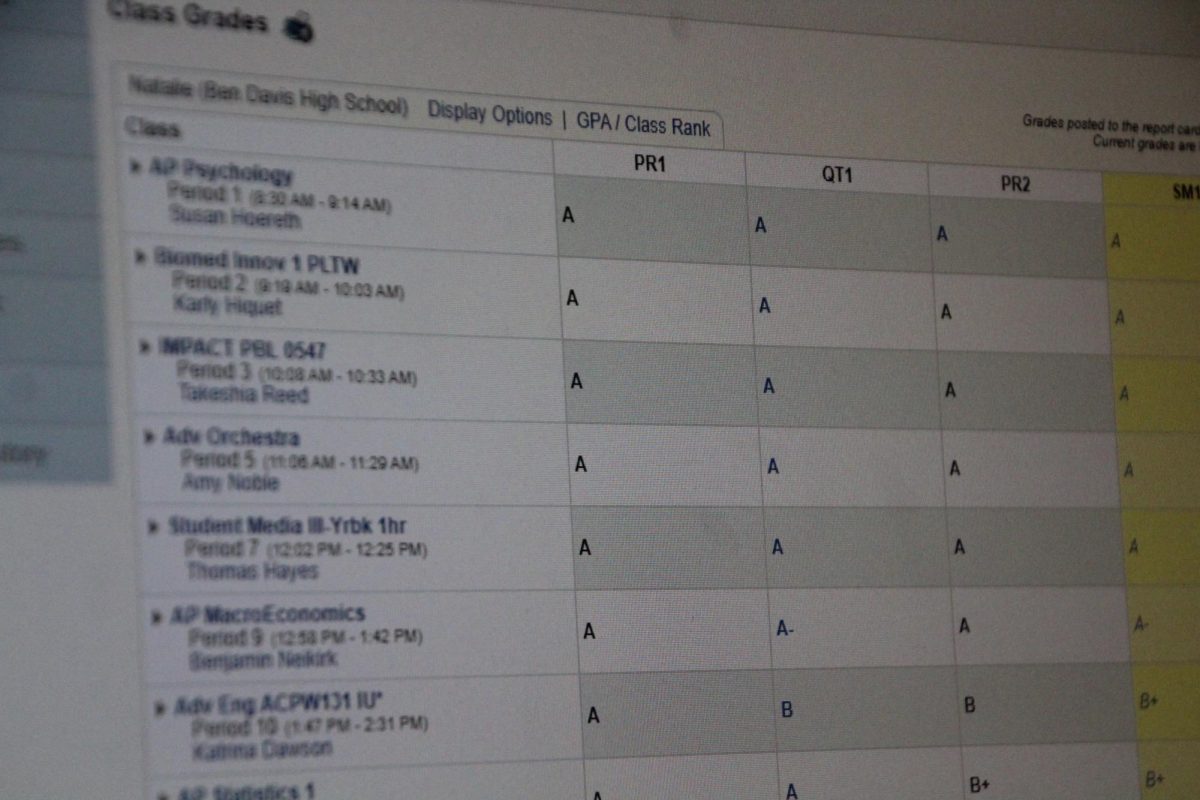School grading systems have been around for as long as we can remember. As students, we often receive grades for everything. Whether it’s a test, essay, small quiz, or even just our participation. However, based on where you are in the world, the grades you receive differ. First, it would be important to understand our own grading system.
| Grade | High Score | Low Score |
| A | 100.0 | 92.50 |
| A- | 92.49 | 89.50 |
| B+ | 89.49 | 86.50 |
| B | 86.49 | 82.50 |
| B- | 82.49 | 79.50 |
| C+ | 79.49 | 76.50 |
| C | 76.49 | 72.50 |
| C- | 72.49 | 69.50 |
| D | 69.49 | 59.50 |
| F | 59.49 | 0.00 |
In Indiana, every public school and any other school that receives help from our government, follow the same student-centered A-F accountability system. More specifically, here at Ben Davis we use the same system that takes our percentages and converts them to a letter grade. Our letter grades are determined by the table to the left. At Ben Davis, students are given ample room to pass classes, with a D being considered a passing grade and students even receiving partial credit for assignments not handed in. However, with that there are downfalls. If a student is in a college-accredited class, they would have to pass with a C or higher to technically be eligible to receive their credit and oftentimes, those classes do not offer partial credit for assignments that regular classes would.
| Grade | High/Low Score |
| A+ | 98-100 |
| A | 93-97 |
| A- | 90-92 |
| B+ | 87-89 |
| B | 83-86 |
| B- | 80-82 |
| C+ | 77-79 |
| C | 73-76 |
| C- | 70-72 |
| D+ | 67-69 |
| D | 63-66 |
| D- | 60-62 |
| F | 0-59 |
Interestingly enough, Indiana’s grading system isn’t the same as some other states. While they may receive an A-F grade, there are some differences.
For instance, a high school called Malden High School, which is located in Massachusetts, has a bit of a different scale than we have here. Massachusetts is said to be one of the highest achieving states in the U.S. in terms of academics. Their scale is presented on the right, and it is interesting because while the scale isn’t drastically different, they do introduce grades that we do not have, showing how not all U.S. states are the same but also not so different.
Considering a lot of the states across the U.S. follow either the same system, or have a similar system, the main differences in how students are graded occur globally.
Let’s take a look at one of the largest countries in the world, Australia. Depending on where you are in Australia, the grading scale used can be different. However, between the different parts there is one scale that is commonly used. They also use a scale where they give their students percentages like we do here, only differing by also placing them in certain divisions.
The divisions are first class, second class upper division, second class lower division, and lastly third division.
Another interesting country to look at in comparison to the United States is Germany.
Different from the U.S. and Australia, they use a 6-point scale to grade their students. While there is also a percentage associated with the points, it is interesting to see students receive points rather than a letter grade like we’re used to. It is also interesting because in Germany, the lower the point the better, rather than the more points you have the better the score is.
While the United States grading scale works for them, there is not one specific grading system that is the correct way to grade students, as each country has and operates with what is best for their students. Below is a table to compare the scales of the two countries mentioned in the article to Ben Davis’s scale.
| BD Grade | BD Score | Aus. Grade | Aus. Score | Ger. Grade | Ger. Score |
| A to A- | 89.50-100% | A+ | 83- 100% | 1+, 1, 1- | 91-100% |
| B+ to B | 79.50-89.49% | A | 73-82.99% | 2+, 2, 2- | 81-90% |
| C+ to C | 69.50-79.49% | B | 63-72.99% | 3+, 3, 3- | 66-80% |
| D | 59.50-69.49% | C | 50-62.99% | 4+, 4, 4- | 50-65% |
| F | 0-59.49% | F | 0-49.99% | 5+, 5, 5-, 6 | 0-49% |








